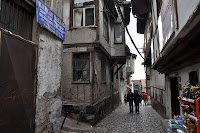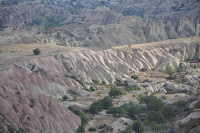10th October 2010
Cappadocia - Ankara - Bolu - Istambul
On the way to Ankara, Central Cappadocia
Because of the distance we had to cover along the day, we were forced to leave Cappadocia very early on our way to Ankara, the capital city (Western Anatolia), where we started by visiting the Citadel, whose foundations are said to have been laid by the Galatians.
The area around the Citadel and inside it are the oldest part of Ankara and having had the chance to wander about it before lunch, we came across several examples of traditional architecture. Its narrow streets, where some of the old houses are recovered and others being recovered ... made me think of some of Lisbon old city quarters.
Partial view of Ankara as seen from the Citadel walls (Left). Citadel walls (Right). Around the Citadel streets (Underneath).
.
 Soon after lunch it started to rain heavily, but we were lucky enough to have a programmed visit to the Anatolian Civilization Museum (an old "covered Bazaar", which has been beautifully restored), considered one of the richest Museums of the world. It holds a huge amount of artifacts from the Paleolithic Age through to the Hittite, Frygian and Lydian periods. These latest ones really caught Christian's attention and mine. We finally managed to get some really good books and the moment we walked out, we felt this well organized Museum had really made our day.
Soon after lunch it started to rain heavily, but we were lucky enough to have a programmed visit to the Anatolian Civilization Museum (an old "covered Bazaar", which has been beautifully restored), considered one of the richest Museums of the world. It holds a huge amount of artifacts from the Paleolithic Age through to the Hittite, Frygian and Lydian periods. These latest ones really caught Christian's attention and mine. We finally managed to get some really good books and the moment we walked out, we felt this well organized Museum had really made our day.

.
 Soon after lunch it started to rain heavily, but we were lucky enough to have a programmed visit to the Anatolian Civilization Museum (an old "covered Bazaar", which has been beautifully restored), considered one of the richest Museums of the world. It holds a huge amount of artifacts from the Paleolithic Age through to the Hittite, Frygian and Lydian periods. These latest ones really caught Christian's attention and mine. We finally managed to get some really good books and the moment we walked out, we felt this well organized Museum had really made our day.
Soon after lunch it started to rain heavily, but we were lucky enough to have a programmed visit to the Anatolian Civilization Museum (an old "covered Bazaar", which has been beautifully restored), considered one of the richest Museums of the world. It holds a huge amount of artifacts from the Paleolithic Age through to the Hittite, Frygian and Lydian periods. These latest ones really caught Christian's attention and mine. We finally managed to get some really good books and the moment we walked out, we felt this well organized Museum had really made our day.
Bronze figurine of a naked woman breastfeeding a baby (from a grave Harozotepe) - New Hittite Period (Right). Goddess Kubaba- Orthostat basalt fragment - Karkamis (700 - 900 B.C.) - Neo Hittite (Left).
We then headed towards the Anitkabir, the Mausoleum of Mustafa Kemal Atatürk, leader of the Turkish War of Independence and founder of the Republic of Turkey. Located on Rasateppe (literally meaning Observation Hill) it is seen by all distinct parts of the city.
Anitkabir with its ten Towers symbolizing the ideas that influenced the Turkish Nation (Left). The hall of Honour - Atatürk's tomb (Right).
Ceremonial Guard at the Mausoleum entrance (Left). The Mausoleum Ceremonial Plaza (Right).
Amongst some of Atatürk's important achievements, is the implementation of a new alphabet for the written Turkish Language, based on a modified Latin alphabet, replacing the old Arabic script, as well as the promotion of modern teaching methods. There has not been a single town we stopped at, in which we haven't either seen his statue or his portrait in display at some public building.
I did feel the Turkish people have a strong admiration for Atatürk, which in a way reminded me of the admiration Cubans still have for Che.
We headed towards Istambul via Bolu having reached the city by dawn ... and although I feel we have spent quite some time on the bus ... I have not disliked today's circuit.
One day to "discover" Istambul, that's what the programme says ... we know now it is not going to be enough ... but we are looking forward to it ...
Anitkabir with its ten Towers symbolizing the ideas that influenced the Turkish Nation (Left). The hall of Honour - Atatürk's tomb (Right).
Amongst some of Atatürk's important achievements, is the implementation of a new alphabet for the written Turkish Language, based on a modified Latin alphabet, replacing the old Arabic script, as well as the promotion of modern teaching methods. There has not been a single town we stopped at, in which we haven't either seen his statue or his portrait in display at some public building.
I did feel the Turkish people have a strong admiration for Atatürk, which in a way reminded me of the admiration Cubans still have for Che.
We headed towards Istambul via Bolu having reached the city by dawn ... and although I feel we have spent quite some time on the bus ... I have not disliked today's circuit.
One day to "discover" Istambul, that's what the programme says ... we know now it is not going to be enough ... but we are looking forward to it ...

















































